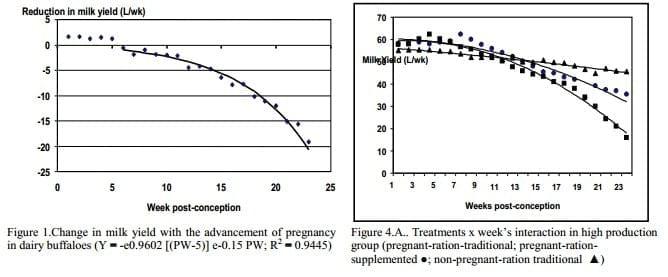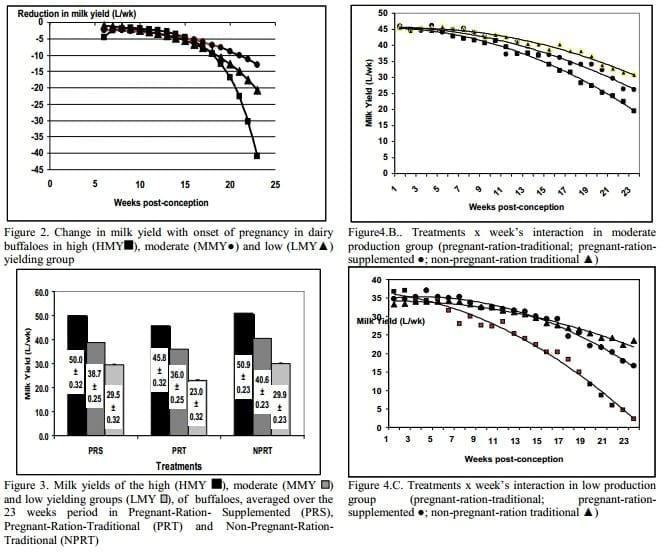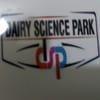Milk Yield of dairy Buffaloes
Modeling and Management of Post-Conception Decline in Milk Yield of Dairy Buffaloes
Dairy buffalo farmers in Pakistan avoid postpartum rebreeding due to fear in milk yield decline. Under the present study reduction in milk yield due to pregnancy was worked out using 23 pregnant and 17 non-pregnant buffaloes under field conditions and the decline was managed through feed supplementation treatments. The treatments provided were Pregnant with traditional ration (PRT), pregnant with supplemented ration (PRS) and non pregnant with traditional ration (NPRT). The animals were categorized into high milk yielder (HMY), medium milk yielder (MMY) and low milk yielder (LMY), producing 66-75, 56-65, and 46-55 liters/wk, respectively. Milk production was recorded up to 23rd week post-conception. The reduction in milk yield became significant on 7th week post-conception. The line JP8 model gave good fit (R2= 0.9527). In the high yielder, the predicted reduction was highest (-4.48 liters/wk) than moderate and low yielder (-2.37 and -0.94 liters/wk). In the high yielder the decline in milk yield post-conception was highest in PRT, moderate in PRS and the least in NPRT treatment. In the MMY buffaloes the supplementation support to milk yield was smaller than the higher yielders. In LMY buffaloes the decline was highest in PRT than the other two treatments. It may be concluded that the onset of pregnancy in dairy buffaloes results in a drastic decline in milk yield at an early stage and the high yielder are more sensitive. An animal becoming pregnant, if supplemented at the rate of 1 kg/2 liters of milk will retain milk yield for a longer duration post-conception.
Key words: Milk yield, pregnancy, nutrition, dairy buffalo
Zicarelli (2006) reported that in countries with temperate climate the cattle are able to express their genetic potential and buffalo can not compete for milk and meat production. In contrast the buffalo milk possesses greater quantity of proteins and for each protein percent point, more than 5 cheese yield points are obtained in buffalo and 3 for cows. The Indo-Pak Subcontinent possesses the best dairy buffalo breeds, named as Nili-Ravi of Pakistan and Murrah of India. It has been anticipated that the buffaloes will be increasingly used for milk and meat production in Asia, especially in the densely populated countries of Indian subcontinent and China (Ranjhan and Qureshi, 2006).
The animals are kept under peri-urban and rural farming systems with the primary aim to produce milk for utilization by the urban and rural populations. This type of farming in the private sector of Pakistan has been described (Qureshi, 1995) where buffaloes are kept in peri-urban areas to meet demand of the urban population. This is a low input dairy farming, depending upon opportunity cost and assets inherited from forefathers.
There is no trend of new investment for establishing farming facilities on scientific lines. No practice of feeding animals according to requirements of various nutrients exists.
Battaglia and Meschia (1978) reviewed the use of available nutrients for milk synthesis and growth of the fetus and concluded that it is minimal for the fetus because the majority of its growth occurs after the lactating cow is dried off. During the seven months of gestation about 40% of fetal growth occurs while the remaining 60% occurs during the last 2 months of gestation. Later on, an early effect of pregnancy was reported in dairy cows on milk production through a combination of hormonally mediated partitioning of nutrients away from milk production (Oltenacu et al., 1980) and increased fetal demands for energy from 190 d of gestation onwards (NRC, 2001). Eley et al. (1978) and Prior and Laster (1979) reported an exponential growth of fetal tissues, with growth rapidly increasing after 90 d of gestation in seasonal herds. In lactating bovines, a complex interaction of several key metabolic hormones viz. growth hormone, prolactin, thyroid hormones and glucocorticoids leads to mobilization of major substrates for milk synthesis eg. acetate, glucose, amino acid and fatty acids during galactopoiesis (Tucker, 1981). Although prolactin is galactopoietic in nature, it has also been attributed to be antigonadotrophic (Tyson et al., 1972 and Rolland et al., 1975).
The above studies have generated useful information on pregnancy - lactation interaction in dairy cows but these can not be applied exactly to dairy buffaloes due to the species variation and the difference in climatic and socio-economic conditions of the farmers. Under the traditional farming system buffaloes are not bred with the fear that the milk production will decline and thus they remain open for longer period, hindering the replacement of lactating animals at the farm. The code of belief amongst farmers and extension people is that the post-conception metabolic adaptation in buffaloes is affecting their milk production more than the body conditions. The extent to which the pregnancy in buffaloes is affecting the production with traditional feeding is not known. This paper reports the decline in milk production of buffaloes after getting conceived and the role of feed supplementation to prevent the decline.
MATERIALS AND METHODS
The present investigations were completed at a Medium sized private buffalo farm in the central valley of KPK, Pakistan situated at 31-37º N and 65-74º E. Forty lactating buffaloes, 3-4 months postpartum were selected for this study. Climate of this region is of continental type. The first part of the study was made to model the predicted decline in milk yield after conception. The second part of this study comprised preventing decline in milk yield through feed supplementation of the pregnant group and to compare it with non-supplemented pregnant and non-pregnant animals.
The period of this study was July to December 2005. All experimental animals were stall-fed and provided green fodder ad lib. Water shower was provided to all animals during hot season twice a day at the farm. Drinking water was provided three times daily. Animal sheds were washed twice daily at morning and evening. Twice a day milking was practiced at 4 am and 4 pm. Vaccines against hemorrhagic septicemia and Foot and Mouth Disease were administered to all experimental animals, as per prevailing practice. Anthelmintic drench of levamisole hydrochloride plus oxychlosanide according to manufacturer instructions was provided at the start of experiment.
Basal ration comprised green fodder ad lib during June through October including maize, sadabahar (sorghum x sudan grass) and sorghum. During November to May, Egyptian clovers, oats, brassica and wheat straw were offered. Traditional ration comprised basal ration and a commercial concentrate; having 18% crude protein and 72% total digestible nutrients at the rate of 1.5 kg per animal irrespective of its lactation stage, milk yield level nd pregnancy stage, as per routine practice under the conventional farming system in the region. This constituted ration for all the non-pregnant and one group of pregnant experimental animals. Supplemented ration included basal ration and the same commercial concentrate provided at the rate of 1 kg per 2 L of milk as recommended by Ranjhan (1994) for lactating buffaloes under tropical conditions. This ration was provided to one group of pregnant animals.
Milk production was recorded daily in liters and pooled to weekly intervals starting from the date of conception through 23rd weeks post-conception. The animals were selected, after conception and pregnancy was confirmed through milk progesterone profiles 21 days post-breeding (Qureshi et al., 2000 b). Treatments included:
PRT (Pregnant-Ration-Traditional, n=12 x 23 weeks)
PRS (Pregnant-Ration-Supplemented, n=11 x 23 weeks)
NPRT (Non Pregnant-Ration-Traditional, n=17 x 23 weeks)
Production groups
HMY: High milk yielder, 66 to 75 L/wk (n=12 x 23 weeks)
MMY: Moderate milk yielder, 56 to 65 L/wk (n=16 x 23 weeks)
LMY: Low milk yielder, 46 to 55 L/wk (n=12 x 23 weeks)
Reduction in milk yield due to pregnancy was calculated as the difference between milk yield of 23 pregnant and 17 non-pregnant buffaloes. The data for milk yield reduction per week for week 1 to 23 of pregnancy were used to investigate milk yield reduction due to pregnancy. Eight different models including Straight line regression, Quadratic equation, Two straight lines with joining point at week 8, A plateau and quadratic curve with a joining point , A plateau and a straight line with a joining point b/w 5.0, 6.0, Two straight lines with joining point at week 12, A plateau and a straight line with a joining point (Draper and Smith, 1981, Neter et al. 1985) and Coulon model exponential function. (Coulon et al. 1995) were compared to calculate
milk yield reduction due to pregnancy.
For dairy cows, Coulon modeled the effect of pregnancy stage on milk yield. In the present study the correction term was modified to Pw - 5, because the effect of pregnancy was noted after 5th week postconception. The modified model was applied as follows:
Y = -e 0.9602{(PW-5)} e-0.15 PW (1)
Milk yield data for each week were statistically analyzed using the following linear model:
Yijk = μ +ρi +αj + (ρα)ij + εijk (2)
Yijkl = μ +ρi +αj + βk + (ρα)
ij + ρβik + αβjk +ραβijk + εijkl (3)
Where, Yijkl is the lth observation of the ith group, jth treatment, and kth week; μ is over all mean; ρi is ith group effect; αj is jth treatment effect; βk is the kth week effect; (ρα)ij is interaction between ith group and jth treatment; αβjk is the interaction between the ith group and kth week; ραβijk is the interaction between the ith group, jth treatment, and kth week; and εijkl is random effect associated with kth animal of the ith group and jth treatment.
Combined analysis was made for the first eight weeks, for the last 15 weeks, and for all the 23 weeks of the milk yield data, because the decline seemed to be affected by pregnancy and ration in weeks- 9 to week-23.
RESULTS
Modeling decline in milk yield: Results of eight different models applied for the calculation of milk yield reduction are presented in Table.1 Two straight lines model with a joining point at 8 weeks had an R2 of 0.9629, while the quadratic model also gave a good fit with an R2 of 0.9863. Empirically, the quadratic model seems to be better because of its higher R2 , but logically we prefer the model with two straight lines as the first line reflects a little decline while the second line gives a drastic decline at certain stage of gestation. In this study two straight lines even gave better fit than Coulon et al. (1995) model (R2=0.9445) for the reduction of milk due to pregnancy.
The reduction initiated after 5th week of conception and became significant on 7th week as evident from the Figure 1. The linear model did not give good fit which is clear from the predicted values of the model (R2 = 0.9237. The quadratic model though gave good fit (R2= 0.9863) yet predicted values seem to be slightly different from the actual values. The line JP8 (joining point at week 8) model also gave well fit (R2= 0.9527) and the predicted values are much closer to the actual values. The decline in milk with advancement of pregnancy was slight up to a point which we declared as joining point; thereafter the decline was much greater.
Figure 2 shows post-conception reduction in milk yield in the high, moderate and low milk yielding buffaloes. The reduction in high yielding buffaloes was slight up to 6 th week but later on it became drastic. In the moderate yielding buffaloes the reduction was the least while in the low producing buffaloes the reduction was slightly greater. In the high yielders, the predicted reduction was the highest (-4.48 L/wk) followed by the moderate and low yielders (-2.37 and -0.94 L/wk), respectively during 6th week post-conception. It shows the higher sensitivity of the high yielding buffaloes to the onset of pregnancy. Total predicted reduction in milk yield due to pregnancy in the various production groups (6-23 weeks post conception) was 173.97, 100.81 and 129.14 L, respectively.
Managing decline in milk yield: The difference in weekly milk yield of buffaloes recorded from 1 to 23 week, as affected by various treatments in the three production groups, are given in Table 3. Difference among the high, moderate and low yielders was significant throughout lactation. The effect of treatment on decline after 5thweek was apparent but became significant in 7thweek. The group x treatment interaction affected milk yield decline on 4th, 6-9th , and 14-15th and beyond 18th week post-conception.
Milk yields of the high, moderate and low production groups of buffaloes, averaged over the 23 weeks period as affected by ration and pregnancy are presented in Figure 3. The average weekly yield of the high yielding animals was 50.0, 45.8, 50.9 L in the pregnant-rationsupplemented (PRS), pregnant-ration-traditional (PRT) and non-pregnant-ration-traditional (NPRT) buffaloes, respectively. For the moderate yielding buffaloes the values were 38.7, 36.0 and 40.6 L/wk, respectively, showing a decline in milk yield in animals, both on supplemented and traditional rations. The low yielders showed a decline pattern similar to the high yielders.
Treatments x week´s interaction are shown in Figure 4 A - 4 C. In the high production group (Figure 4-A), the decline in PRS was moderate while the decline in PRT was the highest and in NPRT was the lowest. These results showed that supplementation of the pregnant animals with concentrate feed maintained milk production levels post-conception while drastic decline in milk yield was seen in pregnant buffaloes on traditional ration. In the moderate production group (Figure 4-B) the supplementation support to milk yield was smaller than the high yielding group. However, beyond the 15th week post-conception, the decline in yield in the pregnant buffaloes on traditional ration was greater. It demonstrates a little beneficial affect of feed supplementation to the moderate yielding buffaloes. In the low production buffaloes (Figure 4-C) the pregnant buffaloes with supplemented ration maintained the milk yield almost similar to the non-pregnant buffaloes on traditional ration.
Combined analysis of milk yield of the 23 weeks: The data were analyzed through combined analysis of variance for milk yield during a period of 23 weeks as shown in Table 4. The difference in milk yield among the production groups (high, moderate and low yielders) and treatments (pregnant with supplemented ration, pregnant with traditional ration and non-pregnant with traditional ration), was significant (P<0.01). Effect of postconception weeks was also significant (P<0.01).
Interaction between production groups x treatments, and treatments x post-conception weeks was significant. Interaction among the production groups x weeks x treatments was also significant. Interaction between production groups x post-conception weeks was non-significant


The present study shows the higher sensitivity of the high yielding buffaloes to the onset of pregnancy. Obviously, the high yielders are more sensitive to conception due to higher energy loss and poor nutritional status. In previous studies Khan and Lurdi, (2002) reported that pregnant goats had lower blood glucose than non-pregnant after day 84 of pregnancy. It was suggested that there may be competition for glucose between the mammary gland and the gravid uterus which would result in milk yield losses due to pregnancy in high yielder. Olori et al. (1997) found that in first lactation the cows were more sensitive to the stress of pregnancy in mid lactation when dairy production was greater than the later stage of lactation. It was suggested that mammary gland is generally less responsive to the onset of conception.
The resource constrained-poor-unaware farmers under the conventional buffalo farming in this region are unable to provide sufficient feeding and management support to these animals. On the other hand they are reluctant for postpartum rebreeding of their high yielding buffaloes for fear of a drastic decline. Findings of thepresent study have demonstrated this post-conceptiondecline in milk yield under the traditional same-scalefeeding regime.
Acknowledgements: Financial sponsorship of the Higher Education Commission of Pakistan made conduction of this investigation possible which is highly acknowledged. Prof. Dr. Pegham Shah assisted in management and analysis of the data. Mr. Kamran Safder provided experimental animals at his commercial buffalo dairy farm, which is highly acknowledged. Mr. Muhammad Nawaz assisted us in traveling to the experimental stations.
Bachman, K. C., M. J. Hayen, D. Morse, and C. J. Wilcox (1988). J. Dairy Sci. 71: 1925-1931.
Battaglia, F. C. and G. Meschia (1978). Physiol. Review. 58: 499-527.
Coulon, J. B., L. Perochon, F. Lescourret (1995). J. Anim. Sci. 60: 401-408.
Draper, N. R., H. Smith (1981). 2 nd Ed. John Wely and Sons Inc. New York. PP: 250-257.
Eley, R. M., W. W. Thatcher, W. B. Fuller, C. J. Wilcox, R. B. Becker, H. H. Head, and R. W. Adkinson (1978). J. Dairy Sci. 61: 467-473.
Erb, R. E., M. M. Goodwill, R. A. Moreson, A. O. Shaw (1952). J. Dairy Sci. 35: 224-233.
FAOSTAT (2010). Statistics Division, Food and Agriculture Organization, UNO, Rome, Italy. www.faostat.fao.org
Genizi, A., H. Schindler, H. Amir, S. Eger, M. Zarchi, R. H. Foote (1992). J. Anim. Prod. 55: 309-314.
Khan, J. R., R. S. Lurdi (2002). J. Trop. Anim. Health and Prod. 34: 151-162.
Neter, J., W. Wasserman, M. H. Kutner (1985). Richard D. Irwin. Inc. Homewood Illinois. PP: 346-351.
Oltenacu, P. A., T. R. Rounsville, R. A. Milligan, and R. L. Lintz (1980). J. Dairy Sci. 63: 1317-1327.
Olori, V. E., S. Brotherstone, W. G. Hill, and B. G. McGuirk (1997). Livestock Prod. Sci. 52:167- 176.
Qureshi, M. S. (1995). Buffalo Bulletin 14: 38-41.
Qureshi, M. S., G. Habib, H. A. Samad, M. M. Siddiqui,
N. Ahmad, and M. Syed (2002). AsianAustralian J. Anim. Sci.15: 330-339.
Ranjhan, S. K. and S. Qureshi (2006). Asian Buffalo Magazine. 3: 4-11.
Ranjhan, S. K. (1994). Animal Nutrition in Tropics. 4th Edition Waqas Publications. New Delhi. India.
Rolland, R., F. H. De Jong, L. A. Schellekens, and R. M.
Lequin (1975). Clinical Endocrinology. 4: 27-38.
Tyson, J. E., H. G. Friesen, and M. S. Anderson (1972).Science 177: 797-800.
Zicarelli, L. (2006). Buffalo development in Asia. Asian Buffalo Magazine. 3: 12-18


United States











